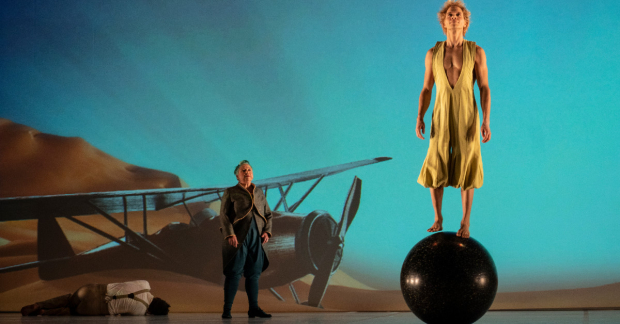Review: The Little Prince Looks Small as It Lands on Broadway
A stage adaptation of Antoine de Saint-Exupéry’s beloved book comes to New York with dance and acrobatics.

(© Joan Marcus)
Ever since Antoine de Saint-Exupéry's novella The Little Prince appeared almost 80 years ago, it has been one of those ubiquitous works of literature that people know about even if they haven't read it, if only for its eye-catching cover drawing of a blond-haired boy standing on an asteroid in space. The book has been translated into dozens of languages and cherished by young people, though with its philosophical musings and somewhat dark ending, it might better be considered a children's book for adults.
You could also say that its new translation to the stage, in an international production that has now arrived at the Broadway Theatre, is a kid's show for grown-ups. It had recent runs in Paris, Sydney, and Dubai before landing in New York, the city where Saint-Exupéry wrote some of the book in 1942. Directed and choreographed by Anne Tournié, The Little Prince retells Saint-Exupéry's story using dance, circus acrobatics, and a narrator (Chris Mouron) in a near-two-hour show that could easily be 90 minutes if not for an overlong intermission. High-flying theatrics and feats of agility would seem like an inspired way to tell the Little Prince's tale of planet-hopping and self-discovery, but unfortunately this production fails to capture the imagination the way the book does, and for the most part it underwhelms.

(© Joan Marcus)
I say this as someone who has covered many circus-and-dance-themed shows that have dazzled in much smaller theaters, such as the New Victory in midtown and Company XIV's Brooklyn venue. The vast stage of the Broadway Theatre does work for this show in one respect — it highlights the physical and existential isolation of the Little Prince (Lionel Zalachas), the Aviator (Aurélien Bednarek) who becomes stranded in the Sahara Desert after his plane crashes, and the story's other lonely characters.
In another respect, however, the sheer size of the stage swallows the production, which has no set to fill the vastness. Instead, scene changes are suggested by a large screen in the rear that displays projections (designed by Marie Jumelin) ranging from surrealistic space-scapes to banal screensaver-like starbursts. These images do re-create the book's otherworldly atmosphere, but they tend to pull the eye away from the performers who already look like they are struggling to be seen.

(© Joan Marcus)
That's a shame for a show that does have some breathtaking moments of beauty, particularly in the first act. Laurisse Sulty, wearing a flowing dress (costumes by Peggy Housset) that when spun blooms like large rose petals, plays the Little Prince's love interest, the Rose, with astonishing grace. She and Zalachas (whose light-green outfit makes him look like a buff Gumby) perform a gorgeous pas de deux on the stage and in the air using aerial straps. Together, their physical chemistry elevates the scene into the show's most memorable moment.
Tournié's efforts elsewhere are less engaging as the Little Prince hopscotches from one planet to the next (also via aerial straps), where he meets a series of grown-ups who illustrate how "strange" people become once they leave childhood behind. The show follows the book relatively closely as the Little Prince meets a power-hungry King (Joän Bertrand), a red-hat-obsessed Vain Man (Antony Cesar), a slovenly Drunkard (Marie Menuge), a maniacal Businessman (Adrien Picaut), a tireless Lamplighter (Marcin Janiak), and more.

(© Joan Marcus)
In these and other dance-heavy scenes (featuring ethereal and quirky music by Terry Truck), the real attraction is Housset's richly colored costumes, with lush reds symbolizing the self-consuming passions of the King and the Vain Man. The Drunkard's scene seems, for a moment, as though it will provide some additional excitement as a performer on a Cyr wheel enters and begins spinning like, well, a drunkard, but this inspired bit of acrobatics is short-lived, and after the Cyr wheel gently swirls to a stop, it never appears again.
Moments like that betray a show that appears uncertain whether it wants to be structured around dance and acrobatics or around quotes from the book. Throughout the Little Prince's encounters, Mouron (sporting green hair designed by Carmen Arbues Miro) narrates the action and dialogue with passages in English and an occasional sentence or two in French. The narration also appears in English on monitors positioned on either side of the proscenium, though Tristan Viscogliosi's clear sound design makes the surtitles mostly unnecessary.
Those who love the book will take pleasure in hearing famous lines like, "It is only with the heart that one can see rightly; what is essential is invisible to the eye." But sadly, Mouron's sometimes booming narration feels more like an intrusion, particularly in later dance sequences involving the Aviator and the Fox (Dylan Barone). In a smaller venue, the dance and the acrobatics might have been all the narration The Little Prince needed, letting what was essential be unheard by the ear.









